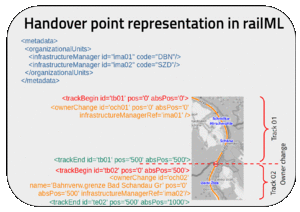Dev:Border between infrastructure managers and countries: Difference between revisions
| [checked revision] | [checked revision] |
(added text) |
m (fixed reference) |
||
| Line 1: | Line 1: | ||
In this example we will consider handover point as it is defined in {{source|title=TAP TSI and TAF TSI Sector Handbook for the Communication between Railway Undertakings and Infrastructure Managers (RU/IM Telematics Sector Handbook) Submitted on 20th October 2022}}: “Point where legal responsibility changes between the Ims. This can be but does not have to be in conjunction with a state border”. | In this example we will consider handover point as it is defined in <ref>{{source|title=TAP TSI and TAF TSI Sector Handbook for the Communication between Railway Undertakings and Infrastructure Managers (RU/IM Telematics Sector Handbook) Submitted on 20th October 2022|author=unknown}}</ref>: “Point where legal responsibility changes between the Ims. This can be but does not have to be in conjunction with a state border”. | ||
[[File:2023-05-23 railML Handover point representation in railML2.gif|thumb]] | [[File:2023-05-23 railML Handover point representation in railML2.gif|thumb]] | ||
Revision as of 17:53, 29 September 2023
In this example we will consider handover point as it is defined in [1]: “Point where legal responsibility changes between the Ims. This can be but does not have to be in conjunction with a state border”.
Real world example of this concept can be found in the OpenRailwayPap defined for the Děčín–Dresden-Neustadt railway 6240 line. This line is operated be two railway operation managers Správa železnic of Czech Republic and Deutsche Bahn Netz of Germany. Schöna is a German railway station and Dolní Žleb is a Czech one.
In railML handover points are represented by the <ownerChange> element. As handover points represent the change of “Ims” <ownerChange> (link to the railML® website) elements of infrastructure subschema refer to <infrastructureManager> ones of metadata.
They affect the definition of the railway tracks. Every railway track should have an <ownerChange> (link to the railML® website) at the beginning of the track positioned at zero coordinate. But also, the additional semantic constraints apply like for the <speedChange> railML2 <speedChange> semantic constraints revision forum post (link to the railML® website):
• Only applies if speedChanges (ownerChange) are exported at all [as they are not required by XSD];
• If both directions are accessible, then <ownerChange> (link to the railML® website) should also be defined for the <trackEnd> (link to the railML® website).
- ↑ unknown: TAP TSI and TAF TSI Sector Handbook for the Communication between Railway Undertakings and Infrastructure Managers (RU/IM Telematics Sector Handbook) Submitted on 20th October 2022
